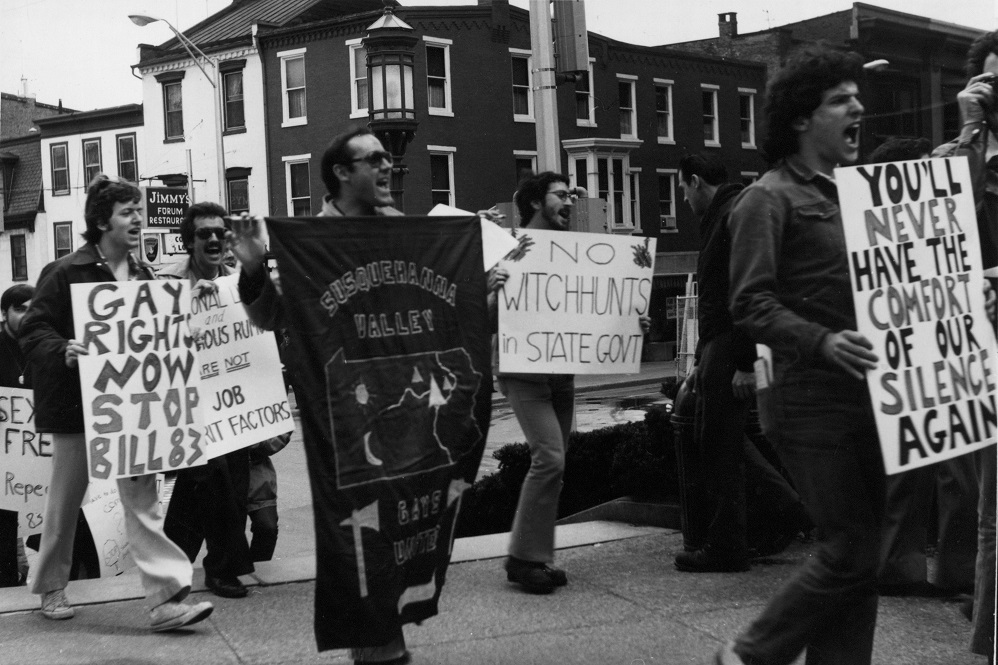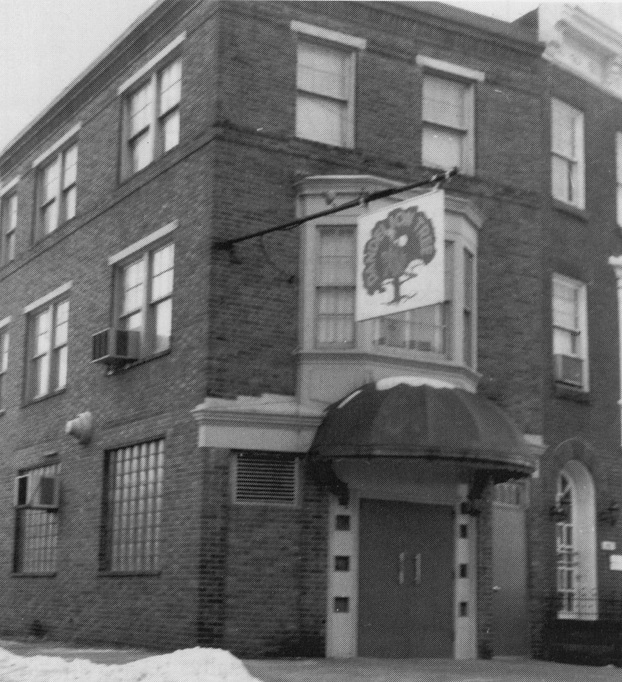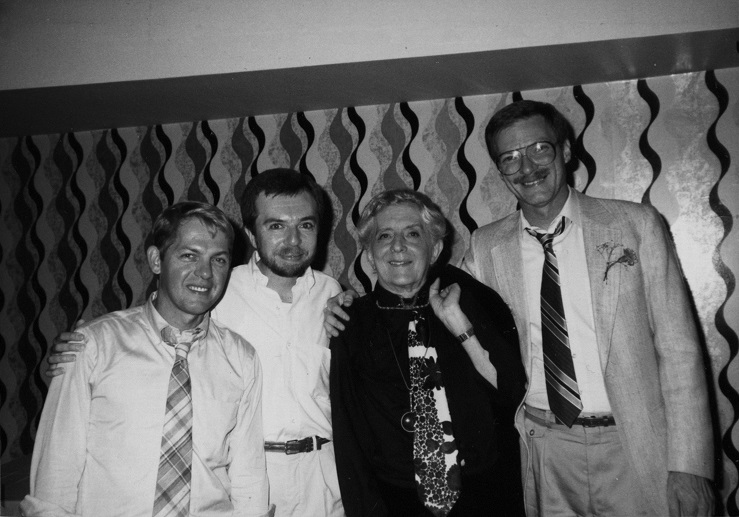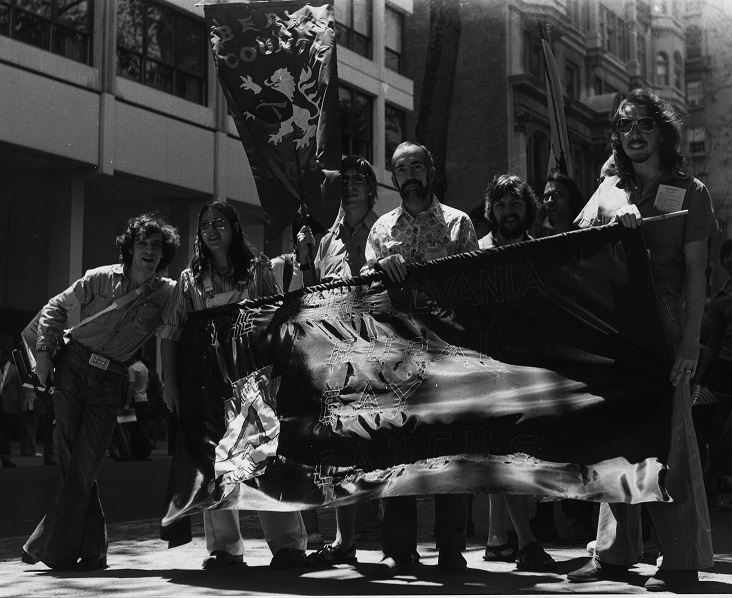October is national LGBT History Month and Pennsylvania has an important place in the history of the modern LGBT (Lesbian, Gay Bisexual and Transgender) civil rights movement. One might assume that history only took place in the state’s major population centers of Philadelphia and Pittsburgh. But as we are discovering, that is not the case.
For the past six years, the LGBT Center of Central PA History Project has been documenting the history of the LGBT community of central Pennsylvania by conducting oral history interviews and collecting documents, photographs and artifacts relating to the history of this community and its struggles for equality. Interviews have been conducted with more than 135 individuals and recorded, mostly on video, and transcribed.

First gay rights demonstration held in Harrisburg, protesting anti-gay legislation introduced into the Pennsylvania legislature in 1977 in reaction to Governor Shapp’s landmark executive orders prohibiting discrimination for state employees on the basis of sexual orientation in 1975, and creating the Pennsylvania Council for Sexual Minorities in 1976; photo by Bari Weaver; courtesy of the History Project of the LGBT Center of Central PA, Archives and Special Collections, Dickinson College, Carlisle, PA.
While most of the narrators are older members of the community who were born in central Pennsylvania and have long-term residence and involvement in the life of the LGBT community, some are from more recent generations, some relocated to Pennsylvania from other places, and some grew up in central Pennsylvania but later moved away. The collection contains a diversity of voices and experiences, and continues to grow with new interviews added each year.

In February 1976, Governor Milton Shapp issued an executive order creating the Pennsylvania Council for Sexual Minorities, the first official governmental body in the nation to advise on public policy changes to eliminate discrimination against sexual minorities. It remained active for about 10 years. In this photo, some of the members of the Pennsylvania Council for Sexual Minorities gather for a group portrait, ca. 1976; Pennsylvania State Archives.
About 100 cubic feet of archival materials including documents, historical photographs, video, and a wide array of three-dimensional artifacts have been carefully collected, catalogued, curated and stored thanks to a partnership with the Dickinson College Archives and Special Collections in Carlisle. It is the fastest growing collection of the college’s archives and is also the most used collection of the archives, accessed by students, faculty, researchers, and volunteers of the LGBT History Project.

Joe Acanfora, with “Gay is Proud” sign, at demonstration at Penn State University, ca. 1971. Photo provided with permission by Joe Acanfora. Joe was one of the plaintiffs in a lawsuit, successfully settled out of court, against the Penn State University administration for pulling the charter for the first gay organization on campus chartered by the University’s student government, called Homophiles of Penn State (HOPS). An education student, Acanfora lost his student teaching assignment, sued and had his student teaching job reinstated by a court order, and graduated from Penn State. Penn State refused to issue his teaching certification. Acanfora moved to Maryland to teach in public schools there only to lose his job again because of the publicity that followed his case when Penn State finally reversed its decision and issued his teaching certification. He would never teach again and changed careers.
This project, with its unique partnership between a community-based organization and a professional archive, was recognized with the prestigious J. Franklin Jameson Archival Advocacy Award from the Society of American Archivists in 2014.
The History Project has made the collection accessible to the public through several exhibits it has mounted over the past six years, including an annual exhibit during LGBT History Month at the Dickinson College Archives located in the Waidner-Spahr Library on its campus in Carlisle, called History Comes Out.
This year, the exhibit will include a reception and open house in the archives on Sunday October 14 from 1:30 PM to 3:30 PM, during which a much larger selection of documents, photographs and artifacts the collection will be on display in the archives research room, along with a selection of video clips of oral history interviews. Also on display will be the LGBT historic sites mapping project using Google Maps to plot all geographical place references we are finding in the oral histories and documents in the collection that may form the basis for conducting future surveys of sites for historical significance.

Harrisburg’s first gay bar was the Clock Bar, which opened in 1938 at 400 North Second Street. It was raided by police and Liquor Control Board agents in 1965 and shut down. It re-opened in 1966 under a new owner and re-named the 400 Club. It remained a gay bar through a series of changes in ownership and names, including the Dandelion Tree shown in this photo, ca. 1977, until its last incarnation, La Rose Rouge, closed in 1990. It is currently the Burger Yum restaurant. ; Photo courtesy of Crossroads Magazine, in the collection of the History Project of the LGBT Center of Central PA, Archives and Special Collections, Dickinson College, Carlisle, PA.
The History Project has also sponsored related programming including lectures, story circles, and documentary film screenings, and is also making an increasing amount of its collection available on the web at www.centralpalgbtcenter.org/lgbt-history-project.
The manuscript for a book has been written, currently titled Out in the Hinterland: Creating a LGBT Community in the Heart of Pennsylvania, and is anticipated to be published by Penn State University Press in 2019. The illustrated book relies heavily on the History Project collection, supplemented by material from other archives and sources, and chronicles the development of the LGBT community in central Pennsylvania through the past seven decades.

Dignity/Central PA started meeting in 1974 and became officially chartered in 1975 as a chapter of Dignity/USA, an organization of LGBT Catholics and their friends. In this photo, some of the founding members gather on the occasion of the 10th anniversary of the chapter, with guest speaker gay British author and actor Quentin Crisp (third from left). Dignity/Central PA remains as the oldest continually operating LGBT organization in central Pennsylvania.; Photo courtesy of the History Project of the LGBT Center of Central PA, Archives and Special Collections, Dickinson College, Carlisle, PA.
The History Project also started the PA LGBT History Network, a collective of more than 100 individuals, organizations and institutions that have LGBT history collections, or are interested in the topic. The network seeks to raise awareness of Pennsylvania’s important place in LGBT history and the many archives, historical societies, museums, organizations and other locations where LGBT history collections can be found.

Members of the Pennsylvania Rural Gay Caucus pose with their banner at the Philadelphia Gay Pride Parade, June 1976. The Caucus was a coalition of various gay organizations from small cities and towns throughout Pennsylvania outside of Philadelphia and Pittsburgh, founded in 1975 and lasted for about 6 years. Photo by Bari Weaver; courtesy of the History Project of the LGBT Center of Central PA, Archives and Special Collections, Dickinson College, Carlisle, PA.
The Network is currently planning an exhibit that will travel around the state in 2019 telling the story of the Pennsylvania LGBT community’s long road to equality by passing local non-discrimination ordinance protections, one city or town at a time. Its debut is timed to coincide with the 50th anniversary year of the Stonewall Uprising, considered a pivotal event that helped spark the modern LGBT civil rights movement. Visit the PA LGBT History Network’s Facebook page at: https://www.facebook.com/groups/625853160935056/?ref=aymt_homepage_panel. To subscribe to the email list, send an email to the-pa-lgbt-history-network@googlegroups.com.
This week’s guest contributor is Barry Loveland, Chair, LGBT Center of Central PA History Project
Thank you for bringing this important part of Pennsylvania’s history to the blog.
Great article Barry, full of wonderful information! Thanks for writing it.